CBSE Class 6 Science Notes Chapter 15 Air Around Us
Wind: When air is in motion, it is called wind.
Air: Air is a mixture of different gases.
Properties of air
- It is colourless i.e., it has no colour and taste.
- It is transparent i.e., we can see through it.
- Air occupies space. It fills all the space in a container which is otherwise empty and seems to be empty.
- Air exerts pressure in all directions.
All living organisms require air for their survival because it contains O2 (oxygen gas) and CO2 (carbon dioxide gas) as parts of its mixture.
Smoke: These are the dark-coloured gases caused by burning of anything.
Weathercock: It shows the direction in which the air is moving at that place.
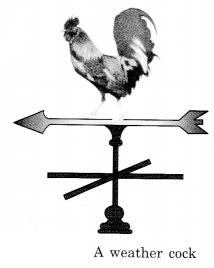
Composition of Air
- Air is not one substance but is a mixture.
- Air is a mixture of some gases, water vapour and dust particles.
- The gases in the air are mainly nitrogen, oxygen, a small amount of carbon dioxide and some other gases.

Water vapours
- Air contains water vapours.
- When air comes in contact with a cool surface, it gets cooled and fog appears.
- The presence of water vapour in the air is important for the water cycle in nature.
Dust particles
- Air contains dust particles.
- The presence of dust particles in air varies from place to place and time to time.
Oxygen
- The component of air that supports burning is called oxygen.
- Oxygen is necessary for the survival of all living beings. It is required in respiration.
- Percentage of oxygen in the air is around 20.95%.
Nitrogen
- The major part of the air is nitrogen. It takes up four-fifth of the space (be around 78.11%) that air fills.
- Nitrogen does not support burning.
Carbon dioxide
- Carbon dioxide makes up a small component (0.03%) of air around us.
- It causes a feeling of suffocation.
- All materials, when they burn consume oxygen and produce carbon dioxide.
- It is also produced along with water vapour during respiration.
- Plants need carbon dioxide for photosynthesis and to live.
Atmosphere
- Our earth is surrounded by air in the form of a thin layer. This thin layer is called the atmosphere.
- The atmosphere extends up to several kilometres.
- The air becomes thinner and thinner as we go high up from the surface of the earth.
- The atmosphere is quite active due to the movement of air, with respect to the earth.
- The processes like cloud formation, thundering, rain etc., occur in the atmosphere. Uses of Air
Uses of Air
- Air exerts force on objects that come in its way. This property of air is quite useful.
- Fun like firkins, pinwheel is based on the force applied by air.
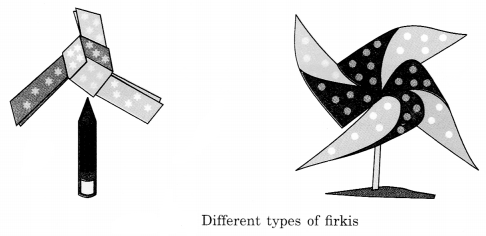
The air current makes the windmills to rotate.
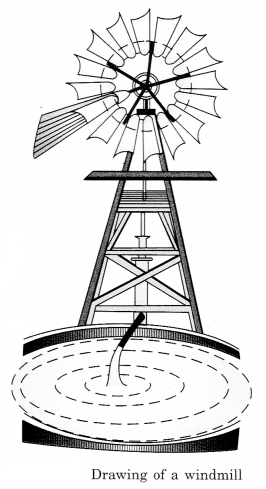
- Air helps in the movements of sailing yachts, sliders, parachutes and aircraft.
- Air also helps in dispersal of seeds and pollens of flowers.
- Compressed air is used in tyres of vehicles.
- Nitrogen is used on a large scale to manufacture fertilizers.
- Winnowing is possible only because of the air.
- Air is also useful for playing several musical instruments.
- Birds, bats and many insects fly in the air.
- We cannot hear the sounds in the absence of air.
- Various components of airplay various important roles.
Atmosphere: The envelope of air that surrounds the earth is known as the atmosphere.
Carbon Dioxide: Carbon dioxide is a gas produced during respiration. It is also produced on burning of organic substances. It is used by plants for photosynthesis.
Composition of Air: Air is a mixture of nitrogen, oxygen, carbon dioxide, water vapour and a few other gases.
Oxygen: Oxygen supports burning and is necessary for living organisms.
Nitrogen: It is the major portion of our atmosphere.
Smoke: These are the dark-coloured mixture of gases produced due to the burning of anything.
Windmill: Windmill is a huge apparatus which is rotated by wind. It is used to draw water from tube wells and to run flour mills.
Air is all Around Us
A thick blanket of air, called the atmosphere, surrounds our Earth. Air is also present in things which seem to be empty. Let us find this out by doing an activity.
Composition Of Air
It contains mainly nitrogen and oxygen. It also contains carbon dioxide, noble gases, water vapour, dust particles, and traces of other gases. The composition of air is shown in Figure 16.1. Let us now verify the presence of some constituents of air.

Nitrogen and Oxygen :
Air contains about 78% nitrogen and 21% oxygen. Oxygen in air supports burning whereas nitrogen does not. Let us prove this by doing a simple activity.
Carbon Dioxide:
Air contains about 0.03% of carbon dioxide. Plants and animals take in oxygen and give out carbon dioxide during respiration. When you burn something, carbon dioxide is also produced.
Water Vapour:
Air contains varying amounts of water vapour depending on the weather of a place. You have learnt about the water cycle. The sun heats up the water in the seas and oceans. This water evaporates and forms water vapour. You can verify the presence of water vapour in air by observing wet clothes drying on a clothesline (Fig. 16.2). Where does the water from these wet clothes disappear? The water from the wet clothes forms water vapour and mixes with the air.
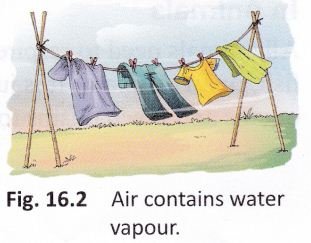
Dust and Smoke:
Have you seen sun rays entering a dark room? Have you noticed tiny particles in the rays? These are dust particles. Air contains dust. Air also contains smoke released from factories and vehicles (Fig. 16.3).

Air Supports Life
We all need air to survive. Air contains oxygen and carbon dioxide useful to plants and animals. Plants use carbon dioxide of the air to make their own food by a process called photosynthesis. Let us see how air supports life in plants and animals.

In Plants:
Plants have tiny pores called stomata, found on the underside of a leaf (Fig. 16.4). Air containing carbon dioxide and oxygen enters the plant through these openings where it gets used in photosynthesis and respiration.
In Animals:
All animals need to respire, be it a cockroach, a fish, or an elephant. It is just that they use different organs and mechanisms for respiration.
Sometimes, we wrongly use the terms of breathing and respiration interchangeably. Breathing is a physical act of taking in oxygen and giving out carbon dioxide, whereas respiration is a chemical process by which glucose in the body breaks down to give energy.
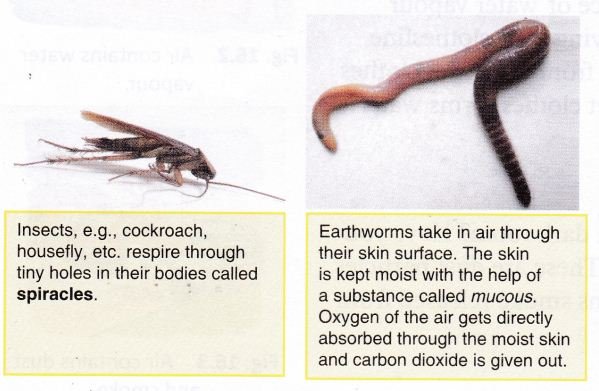
In Aquatic Animals and Plants:
Most aquatic animals like fish, tadpole, crab, and shrimp have special organs for respiration called gills. Gills help to take in oxygen and give out carbon dioxide. Some aquatic animals like dolphin and whale come to the surface of the water regularly to take in air, since they breathe with the help of the lungs.
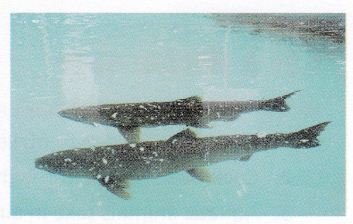
Aquatic plants like Hydrilla also breathe in oxygen dissolved in water through their stomata.
In Amphibians:
Amphibians like frog, newt, and salamander need breathing systems for both air and water. Crocodile and alligator swim through water with part of their snout above the water surface to breathe easily through nostrils.
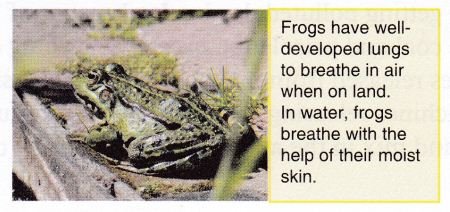
In Birds:
Birds have an efficient respiratory system as they need high levels of oxygen during flight. Birds have a pair of lungs with air sacs that remain open all the time, so that air can easily pass through them.

In Mammals:
Most mammals breathe with the help of lungs.
They take in oxygen and give out carbon dioxide.
Balance Of Oxygen And Carbon Dioxide In The Air
The balance of oxygen and carbon dioxide in the atmosphere is maintained through respiration in plants and animals and by photosynthesis in plants. Plants produce oxygen during photosynthesis and utilize oxygen during respiration. They produce much more oxygen during photosynthesis than they consume, during respiration This is how the oxygen consumed by plants and to a large extent by animals is replenished in the air through photosynthesis.
Air Pollution
The addition of substances in the environment in quantities that are harmful to live beings is called pollution. Air is getting polluted day by day because of various human activities. Burning of fuels like coal and petroleum, excessive burning of fuels like wood, smoke and harmful gases released from industries (Fig. 16.5), smoke released by vehicles (Fig. 16.6), and machines releasing gases are the major causes of air pollution. These gases spread and mix in the air and spoil the quality of air, thereby making it impure.
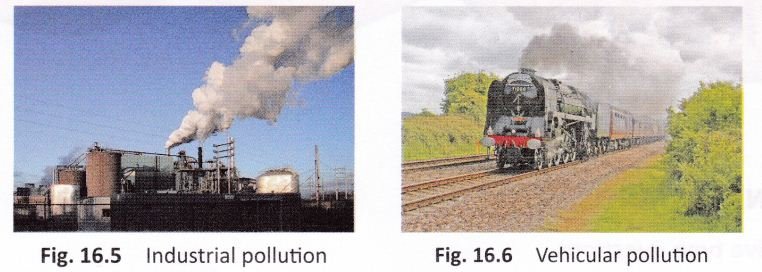
Air pollution has major adverse effects on plants, animals as well as human beings. Harmful gases present in the polluted air make breathing difficult. Air pollution also leads to a lot of lung disease like asthma and lung cancer. Air pollution also damages crops.
If we do not start looking after the quality of air around us, the oxygen and carbon dioxide levels will no longer be balanced and living beings will be the ones getting affected.
There are a number of ways by which we can reduce air pollution. Some of them are: planting more and more trees, recycling plastics, regular checking of vehicles for the emission of harmful gases, etc.
Atmosphere: A thick blanket of air Pollution The addition of substances in the surrounding the Earth’s surface is called the environment in quantities that are the harmful atmosphere. to living beings is called pollution.
All living organisms need air to survive. Air cannot be seen but can be felt when it moves.
Air is a mixture of several gases.
Oxygen is needed for respiration. Carbon dioxide is given out as a by-product after respiration.
Insects take in air with the help of tiny holes in their bodies called spiracles; earthworm breathes through their skin, which is kept moist with the help of a substance called mucus.
Some aquatic animals like whale and dolphin as well as mammals breathe with the help of lungs.
Amphibians like frog breathe with the help of lungs, when on land. In water, these animals breathe with the help of their moist skin.
Birds breathe through lungs and air sacs that are open all the time.
There are several causes of air pollution: excessive burning of fuels like wood, coal, and petroleum, machines releasing gases, vehicles releasing smoke, and several types of harmful gases released by industries.